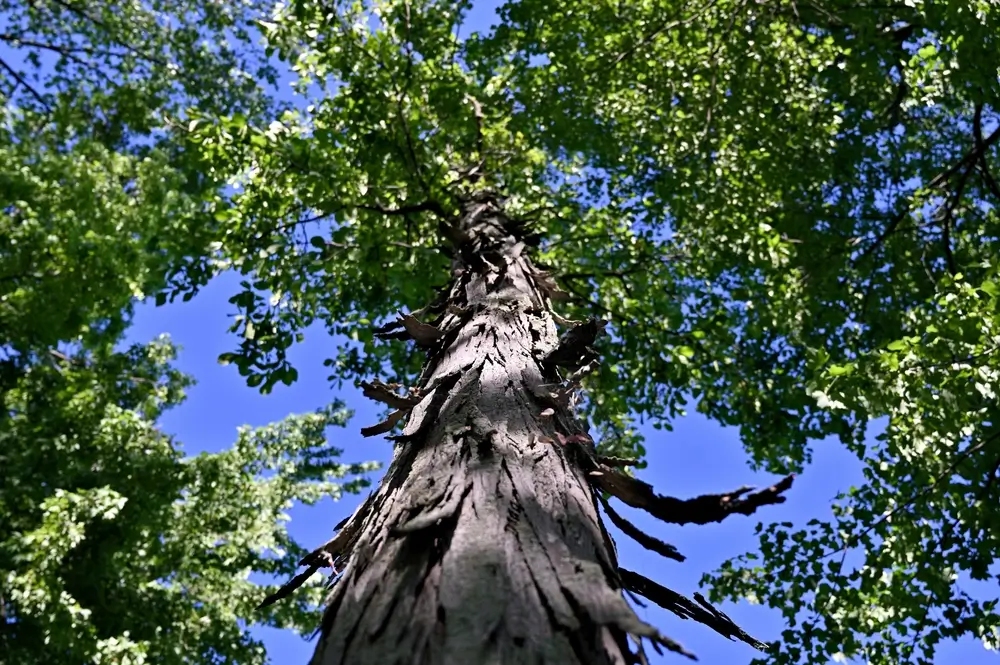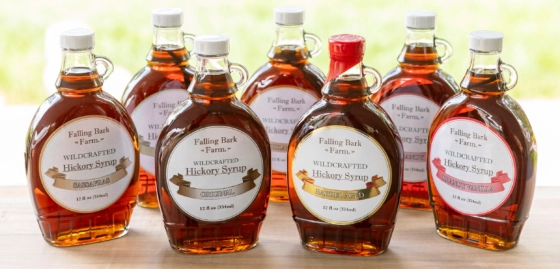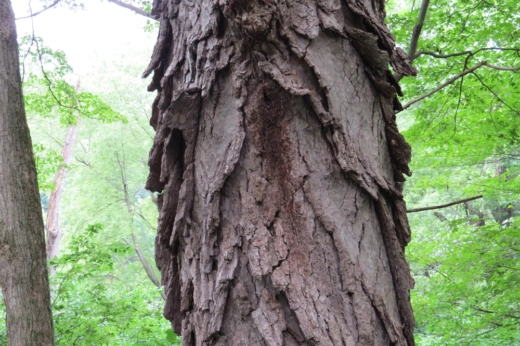Meet the Virginia Retirees Making Sweet and Smoky Syrup from Fallen Bark
Joyce and Travis Miller are two of just a handful of hickory syrup producers in the world today.
Meet the Virginia Retirees Making Sweet and Smoky Syrup from Fallen Bark
Joyce and Travis Miller are two of just a handful of hickory syrup producers in the world today.

A shagbark hickory tree.by Shutterstock.
Enter just about any American supermarket and you’re bound to find a jug of maple syrup somewhere. Hickory syrup? Not so much. Maples and hickories make up a small fraction of the approximately 1,000 native North American tree species, but only the former is well represented within our modern regional food culture, despite the fact that something flavorful and nutritious can be harvested from many of these native trees.
Joyce and Travis Miller had long lived among hickories in the woods of Clarke County, Virginia and had retired from their careers before ever tasting hickory syrup. Twelve years since then, they’ve founded their own operation, Falling Bark Farm, and are two of just a few hickory syrup producers in the world today.
This later-in-life endeavor was a natural next chapter for the Millers, who had always been interested in feeding themselves from the land through gardening, hunting and foraging. Travis had worked in the grocery business for 30 years, as well as in a reclaimed lumber facility, so it wasn’t a huge leap to making food from trees.
In 2011, having just entered retirement but looking for a way to keep busy and keep earning some kind of income, Travis and Joyce asked themselves: “What could we take to the farmers market?”

They had heard from a neighbor about hickory syrup and, given their proximity to many hickory trees, decided to give it a go. The Millers ordered 48 empty glass bottles and began researching the syrup-making process, which has roots in Native American culinary and medicinal practices. (Hickory bark is extraordinarily high in magnesium and has been historically used as a health supplement.)
“When we started out, we would go into the woods ourselves to harvest bark,” says Travis. Unlike with maple syrup, where a hole is drilled into a maple tree to extract its sap, hickory syrup is made with the bark of a shagbark hickory tree that is collected after it has fallen to the ground. No harm is done to the tree.
To make the syrup, the Millers scrub the harvested bark clean, then toast it on an open flame grill to enhance the flavor. Next, they simmer the bark in water on their home kitchen stovetop to make a hickory extract. This is combined with turbinado sugar and, as with the making of maple syrup, a hydrometer is used to test the syrup’s density and determine its sweetness.
No additives, thickeners or dyes of any kind are added. Falling Bark Farm does, however, offer some naturally flavored hickory syrups, including a syrup infused with whole vanilla beans, another aged in bourbon barrels borrowed from a nearby distillery and a “Woodland Spice” variety made with cinnamon, cardamom, clove and allspice that is especially popular around the winter holidays.
“We’re bottling one at a time and everything’s done by hand,” says Travis, explaining that he and Joyce continue to do everything themselves, even as the business has grown to approximately 3,000 gallons of syrup a year. “It’s a little crazy at times, but we’re holding it together.”

While the Millers still sell their hickory syrup in person at about a half dozen events annually, after their first year as vendors at local farmers markets, they’ve focused primarily on sales through their website and local businesses.
“The type of product we have is not like a loaf of bread where you consume it during the week or a bottle of wine that might be shared and finished in a single sitting. After four or five weeks at a farmers market, you’ve reached the regular attendees and then the consumer needs time to use the product,” explains Travis. “We got into doing selective private labeling for significant historical locations, like Monticello and Mount Vernon. That’s been a big bonus for us because it also taps into tourism, not just local consumers.”
Demand for Falling Bark Farm’s hickory syrup has grown to the point that the Millers are no longer harvesting their own bark from just around their land. “Some of our bark comes from the timber industry, where the log has been harvested and, at that point, there isn’t any value to the bark,” says Travis. “We’re taking a waste product and turning it into something that people enjoy.”
In this way, the Millers are a midway point in a sustainable system that honors all that the hickory bark has to offer. After they have made syrup, they pass along the bark to a local barbecue business that uses it to prepare the smoked foods on their menu.

Falling Bark Farm’s hickory syrup itself has found its way onto the menus of many restaurants throughout Virginia and surrounding states, becoming a star ingredient in a broad range of dishes and drinks. With its golden-brown color and thick, slow-pour consistency, hickory syrup is similar in appearance to maple syrup and can also be used as a sweetener in foods and beverages, but it has an aroma and flavor all its own that is slightly smoky and earthy with a hint of molasses.
The Millers have been surprised by the diversity of dishes and drinks that customers and clients have prepared with their hickory syrup—everything from savory meals of grilled salmon and roasted lamb shanks to side dishes of baked apples and cast iron skillet grits with ramps to craft cocktails and beers—and by the community that has flourished along with their business.
“One of the best things about making the syrup has been all of the people that we’ve met,” says Joyce. “We’ve been overwhelmed with kindness.”
Follow us
This work is licensed under a Creative Commons Attribution-NoDerivatives 4.0 International License.
Want to republish a Modern Farmer story?
We are happy for Modern Farmer stories to be shared, and encourage you to republish our articles for your audience. When doing so, we ask that you follow these guidelines:
Please credit us and our writers
For the author byline, please use “Author Name, Modern Farmer.” At the top of our stories, if on the web, please include this text and link: “This story was originally published by Modern Farmer.”
Please make sure to include a link back to either our home page or the article URL.
At the bottom of the story, please include the following text:
“Modern Farmer is a nonprofit initiative dedicated to raising awareness and catalyzing action at the intersection of food, agriculture, and society. Read more at <link>Modern Farmer</link>.”
Use our widget
We’d like to be able to track our stories, so we ask that if you republish our content, you do so using our widget (located on the left hand side of the article). The HTML code has a built-in tracker that tells us the data and domain where the story was published, as well as view counts.
Check the image requirements
It’s your responsibility to confirm you're licensed to republish images in our articles. Some images, such as those from commercial providers, don't allow their images to be republished without permission or payment. Copyright terms are generally listed in the image caption and attribution. You are welcome to omit our images or substitute with your own. Charts and interactive graphics follow the same rules.
Don’t change too much. Or, ask us first.
Articles must be republished in their entirety. It’s okay to change references to time (“today” to “yesterday”) or location (“Iowa City, IA” to “here”). But please keep everything else the same.
If you feel strongly that a more material edit needs to be made, get in touch with us at [email protected]. We’re happy to discuss it with the original author, but we must have prior approval for changes before publication.
Special cases
Extracts. You may run the first few lines or paragraphs of the article and then say: “Read the full article at Modern Farmer” with a link back to the original article.
Quotes. You may quote authors provided you include a link back to the article URL.
Translations. These require writer approval. To inquire about translation of a Modern Farmer article, contact us at [email protected]
Signed consent / copyright release forms. These are not required, provided you are following these guidelines.
Print. Articles can be republished in print under these same rules, with the exception that you do not need to include the links.
Tag us
When sharing the story on social media, please tag us using the following: - Twitter (@ModFarm) - Facebook (@ModernFarmerMedia) - Instagram (@modfarm)
Use our content respectfully
Modern Farmer is a nonprofit and as such we share our content for free and in good faith in order to reach new audiences. Respectfully,
No selling ads against our stories. It’s okay to put our stories on pages with ads.
Don’t republish our material wholesale, or automatically; you need to select stories to be republished individually.
You have no rights to sell, license, syndicate, or otherwise represent yourself as the authorized owner of our material to any third parties. This means that you cannot actively publish or submit our work for syndication to third party platforms or apps like Apple News or Google News. We understand that publishers cannot fully control when certain third parties automatically summarize or crawl content from publishers’ own sites.
Keep in touch
We want to hear from you if you love Modern Farmer content, have a collaboration idea, or anything else to share. As a nonprofit outlet, we work in service of our community and are always open to comments, feedback, and ideas. Contact us at [email protected].by Elena Valeriote, Modern Farmer
October 20, 2023
Modern Farmer Weekly
Solutions Hub
Innovations, ideas and inspiration. Actionable solutions for a resilient food system.
ExploreShare With Us
We want to hear from Modern Farmer readers who have thoughtful commentary, actionable solutions, or helpful ideas to share.
SubmitNecessary cookies are absolutely essential for the website to function properly. This category only includes cookies that ensures basic functionalities and security features of the website. These cookies do not store any personal information.
Any cookies that may not be particularly necessary for the website to function and are used specifically to collect user personal data via analytics, ads, other embedded contents are termed as non-necessary cookies.
Loved this article. Sounds like a neat product, this hickory syrup.
It’s a lovely story, but the way this “hickory syrup” is described and compared to maple syrup seems confusing. The article says that “no additives…of any kind are added” yet describes adding cane sugar. Is this where all the sugars in the product come from? How then is “hickory syrup” not just hickory-bark-flavored sugar syrup? Tasty, I’m sure, perhaps also rich in magnesium, but a far cry from maple or other syrups made from the sugars already in the sap/juice of the plant itself, where literally nothing is added. It certainly seems disingenuous (if not outright inaccurate) to say it’s… Read more »
I agree with thee other comment about “no additives” when earlier in the article it states that turbinado sugar is added. Am I missing something here?